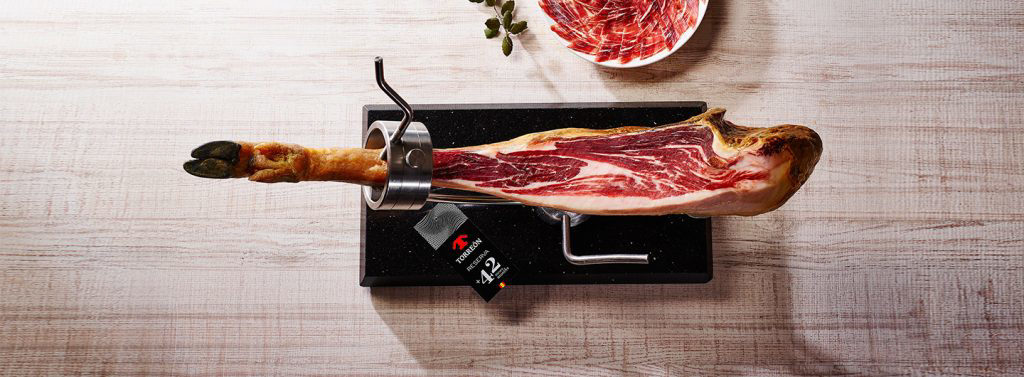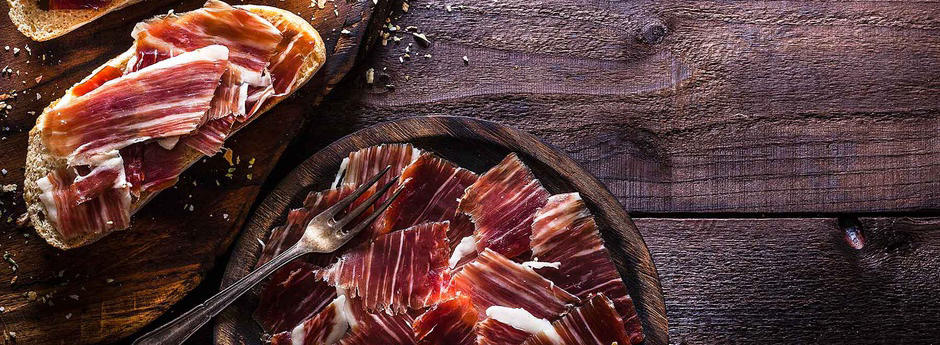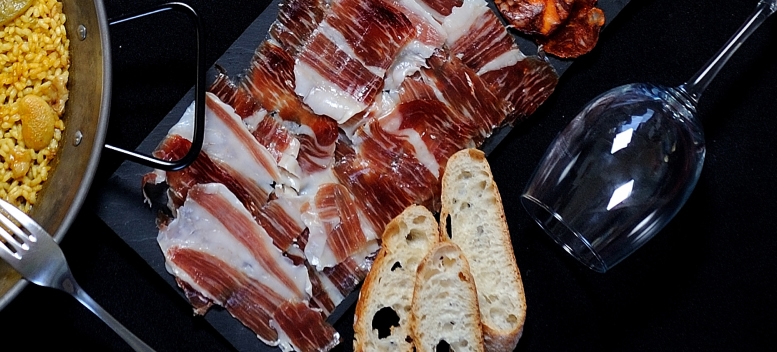Many people ask themselves: What is the importance of cutting cured ham in one way or another? What are the differences in the results? In the following article we will explain how to cut ham by knife like a real professional.
Well, the first thing we would like to point out is that we are no experts and therefore we will try to convey to you the information and opinions that we have been able to gather from different specialized forums. We will do it in a simple and plain language, so that we all can understand it.
Advantages of cut ham by knife:
According to experts, cutting ham by knife has the following advantages:
Firstly, cut ham by knife allows a better distinction of the different parts, characteristics and flavours of the serrano or Iberian ham. As you know there are different types of ham, if you want to know them, you will find them here.
Secondly, the slice of ham is smoother than the one cut by machine. This helps the ham keeping its fat and juices in the cut ham slice. While the machine cuts the slice faster, therefore it drags some of those components. This aspect will also depend on whether the pork ham is of Iberian breed or a white ham.
Thirdly, when we cut ham by knife, if done correctly, the cut should be made in the direction of fiber which will give a better and more adequate consistency to the ham in its tasting.
However, not everything is an advantage when cut ham by knife, there are also drawbacks, such as the slowness of the cutting, or the fact that at home a Gran Reserva ham lasts longer. Although the necessary precautions are taken, the undesired drying or excessive curing of the piece can happen, and this will cause the loss of many of its properties and virtues.
This has led to the fact that, more and more, the service of cut ham by knife is offered in butchers, along with the service of vacuum packaging in small batches, in order to take advantage of this type of cut and delete the inconveniences that it has. Although we should also note that sliced ham, either if it is cut by hand or by machine, loses more quickly its properties.
Once determined to carry out the cut ham by knife, we will continue with the analysis of this process step by step. Starting with the choice of a good ham, which has to be as suitable as possible for this type of cut, then, the provision of the necessary elements to carry it out and, finally, the manner of making the cutting.
Choice of ham for knife cutting
Firstly, it is important to make a good choice of a natural to cut ham it by knife, it is something obvious. We want to get the best ham without putting a strain on your wallet, with its appropriate level of curing, neither very tender, (it is essential not to choose a raw ham) which makes it difficult to make clean cuts, nor very cured, that makes it difficult to cut due to its excess of hardness or consistency. When it comes to the type of ham and its quality both Serrano ham and Iberian acorn ham should have the best one. Knife cutting improves the organoleptic characteristics, but it is not miraculous, and therefore it cannot turn a mediocre product into a good one. Each ham has its own moment, discover the different types of ham here.
If you want to buy an Iberian ham online or if you are looking for a good Serrano ham, take a look at the Gastronomic Spain online shop. The ham shop with Free shipping to Europe. Offer of cheap Serrano and Iberian hams.
Choice of the cooking utensils needed to cut ham by knife
The second point is the choice of the suitable cooking utensils to cut ham by knife.
It seems to us that the best ham knife has to be always perfectly sharp, and in this case, it was not going to be an exception.
Types of ham knife to cut ham leg
We recommend you three types of knives: the first one is a good ham knife. It is flexible and it has a long blade, about 25 to 30 cm by 2cm. The second one is a wide and strong knife, it is also sharp so it is easier to clean the pork and peel its bark. The third one, which some people think it is unnecessary since the second one is very complete, is a puntilla knife to cut around the bones, when needed.
It is very important to choose the right ham holder
In addition, it is essential to have a good ham holder that firmly holds the ham leg in the desired position, which is preferably horizontal. Both a rotating and a professional ham holder are very useful kitchen utensils. When choosing a ham stand, keep in mind three aspects: how much ham you are going to buy, whether you have enough space in the kitchen or not and the budget that you want to spend buying that wooden ham you like so much.
Finally, it is convenient to have ham tweezers to hold and remove the ham slices when cutting.
The way to cut ham by knife
Therefore, we already have everything we need, and we only need to carry out the cut ham by knife which is what we want. If you don’t know which Iberico or Serrano ham to choose, we encourage you to check us out, we will find the ideal ham for you.
It is commonly said that an image is worth a thousand words and this case is not an exception. Therefore, it is advisable to pay attention to some of the numerous videos that can be found on the internet about this work. However, we will also give you some initial and basic advice.
Firstly, the cut should always be made from the hoof to the tip of the ham, since this is the direction of the muscle fibers, it is ideal to place the bait ham horizontally, with the pork’s hoof up, so you can start by cutting the ham mace.
Secondly, you should start cleaning and removing the ham rind. It is not advisable to remove more than the rind, since it helps the cured ham to stay in good condition and not to dry, or at least not to do it so quickly. To do this, we will use the big knife that we have named before as number two.
Then, we will make a wedge cut of 3 cm. of the ham bone that is between the mace and the hoof, reaching the bone, which will serve as delimitation or beginning of the cut when we reach that level. When we finish the ham, we’ll use that codillo ham bone, to make a good homemade ham stock.
Finally, we will start to cut the whole leg ham always keeping the parallelism with the line that joins the hoof and the tip. Therefore, we will start with the part of the mace that is higher and then we will continue descending until reaching the bone part at end of the mace. The direction of the cut is from the hoof to the tip and towards the body, not outward, and therefore special care should be taken not to cut yourselves. When we reach the bone, we will use ham knife or the puntilla knife to cut ham and separate the ham around it and thus facilitate the following slice.
The cuts should be done covering the entire width of the piece which should be about 3 cm-long, since it improves the perception of the aroma of the ham. We should use the tongs to hold the slice while we are cutting it and place it later on the dish.
When we are finished cutting the ham mace, we turn the ham, and we proceed to the cutting of the contramaza following the same criteria.
Then we proceed to the cut of the tip and finally to the cut of the ham that remains on the sides after having cut the mace and contramaza.
Obviously, this requires practice and firstly, the result may be improvable, but with some patience and attention, the results will be acceptable in no time.
The fine cutting increases the ease for drying them and therefore, it is recommended to consume them as they are cut, avoiding keeping the long periods once they are cut.
We hope that these recommendations and the consequent practice are useful for you to carry out the cut ham by knife and also that you enjoyed its desired tasting.









